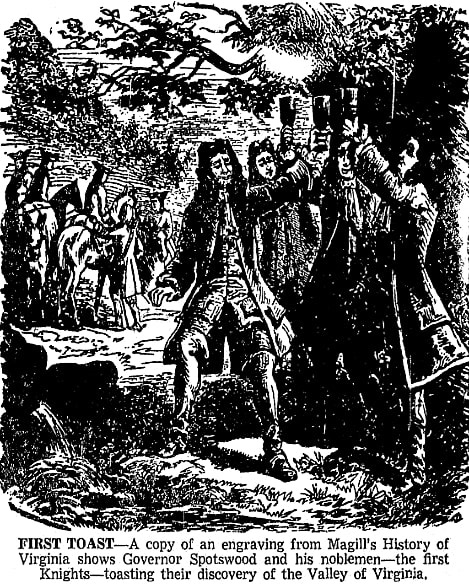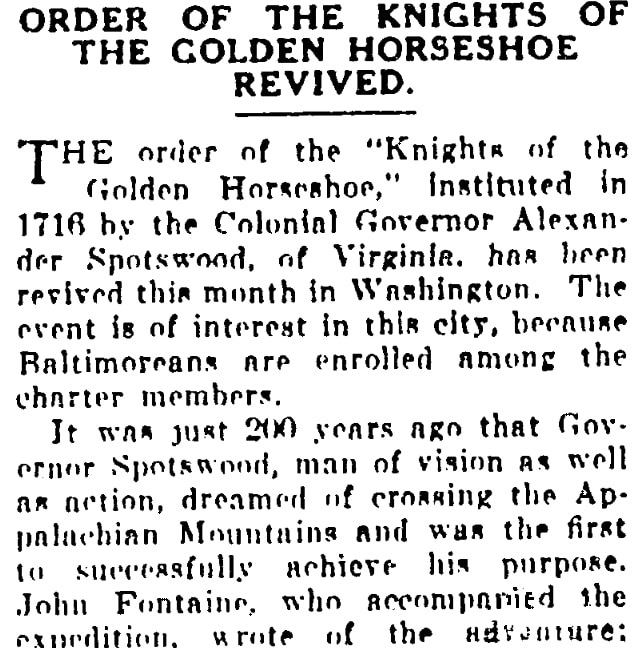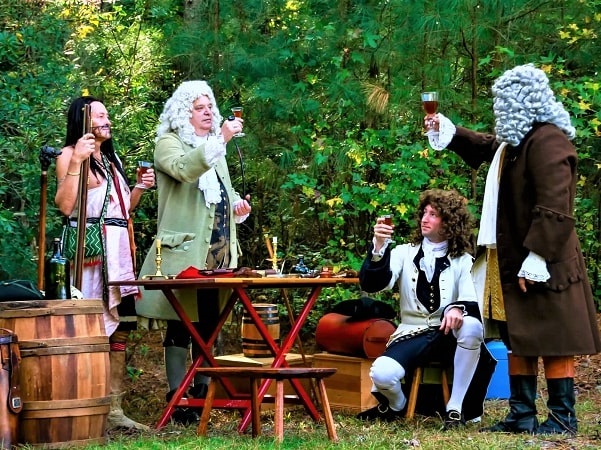Introduction: In this article, Melissa Davenport Berry continues her series on descendants of the Jamestown settlers, writing about the order of the Knights of the Golden Horseshoe. Melissa is a genealogist who has a blog, AnceStory Archives, and a Facebook group, New England Family Genealogy and History.
While Old Romance shall ne’er grow stale
Nor gallantry grow tame
Your lives and love shall ne’er be bale
With each Colonial Dame.
So, ride Sir Golden Horseshoe Knight
Fear not oblivion’s shame
The story of this noble height
Keeps the Colonial Dame.–Rosewell Page (1858-1939)
Today I continue with my “Jamestown Descendants: Who’s Who” series and focus more on the order of the Knights of the Golden Horseshoe, which was organized in 1716 by Virginia Governor Alexander Spotswood, aka the “Architect of Empire” – who led his “merry band of men” on exploration westward and crossed over the Blue Ridge Mountains. I must say the archives about the exploration note that much liquid courage aided them on their daring expedition!

Several generations of Jamestown descendants have paid homage to these daring “knights” through organizing their own ordered society, preserving them via monuments, or writing their story. A list of the original Knights is at Americana-Archives.
To begin, I refer to the article in the Sun newspaper from my last post that reported when the order of the Knights of the Golden Horseshoe was revived in 1916 by many Jamestown descendants, including Lyon Gardiner Tyler. (See: Jamestown Descendants: Who’s Who, Part 16.)

This article reported:
The order of the “Knights of the Golden Horseshoe,” instituted in 1716 by the Colonial Governor Alexander Spotswood of Virginia, has been revived this month in Washington [D. C.]
The event is of interest in this city because Baltimoreans are enrolled among the charter members.
It was just 200 years ago that Governor Spotswood, man of vision as well as action, dreamed of crossing the Appalachian Mountains and was the first to successfully achieve his purpose. John Fontaine, who accompanied the expedition, wrote of the adventure [Fontaine’s Journal];
Hugh Jones, A.M., chaplain of the “Honorable Assembly” and minister at Jamestown, Va., retold the picturesque narrative in 1724; Howe the historian; Edward Ingle, of Baltimore; and many others to whom the adventure made appeal, told the story, each in his own way. From these painters of past events is glimpsed a picture of Governor Spotswood and John Fontaine setting gayly out, on August 20, 1716, to attempt that which had hitherto been deemed impossible. They were joined enroute between Williamsburg and Germania by several gentlemen, 14 rangers and four Meherrin Indians. They carried ample provisions and did not lack liquid refreshment, for their scribe enumerates “white and red wine, usquebaugh [whiskey], brandy, shrub, two kinds of rum, champagne, canary, cherry punch, and cider.” (Verily, there was some joy in living in those days before the moral uplift movement struck us.)
The article reported that many toasts were made, each with a fired volley, when they reached the mountain’s summit,
…where they cut his Majesty’s name upon the rock of the highest peak, naming it Mount George, in honor of their sovereign, King George I, and the next highest peak Mount Alexander, in honor of Governor Spotswood. Finally, they descended to the Valley of the Shenandoah, loaded their muskets and feasted. They drank the health of the King in champagne and fired a volley; the health of the Princess in burgundy and fired a volley; the health of all other members of the Royal family in claret and fired a volley; and wound up by drinking the health of the energetic Governor who had led them to this promised land – not forgetting the volley.
Basically, the company of explorers feasted and partied like rock stars at night and pressed on sturdily by day.
The Sun also reported the skinny on how Spotswood knighted each member:
And then they rode homeward as cheerily as they had set out, reaching Williamsburg September 17, having traveled 438 miles. To commemorate the event and encourage new enterprises and settlements westward, Governor Spotswood gave to each of the company a miniature golden horseshoe set with garnets to represent nail heads. Upon each was the inscription “Sic jurat transcendere montes” (thus he swears to cross the mountains) and on the reverse side was inscribed the tramontane order. Thus, the members of the expedition were known as the “Knights of the Golden Horseshoe” and any gentleman was entitled to wear this golden horseshoe that could prove he had drunk his Majesty’s health upon the summit of Mount George.
Spotswood and his team continue to inspire generations, as in the lines from the above poem by Rosewell Page, a direct descendant of Mann Page – who was one of the original knights.
Page merges the history of the Knights of the Golden Horseshoe with their brave female counterparts who would form their own organization known as the National Society of Colonial Dames of America.
In 1921 a monument was dedicated to Spotswood and his knights. I found a news clip from the Richmond Times-Dispatch reporting that Virginia lawyer and prolific writer Armistead Churchill Gordon read an address at the dedication ceremony. Also present was Mrs. William Ruffin Cox, president of the Colonial Dames of Virginia (whose society funded and made the monument possible). She presented the monument to Gov. Westmoreland Davis.
Another tradition to preserve the knights was captured in this 1958 Richmond Times-Dispatch article that featured three photographs.
This article reported:
Most of the knights bearing names well known in Virginia today passed on to their descendants their love of the outdoors, horses and the hunt. So it is not so farfetched that sponsors of the Deep Run Hunt Races, many of them bearing names of the early knights or counting them among their ancestors, should have decided to have annually the Golden Horseshoe Ball. This year’s ball, to be held at the Commonwealth Club on April 5, date of the races at the Atlantic Rural Exposition Grounds, will follow a custom of using golden horseshoes for the decorative theme.
And while the music and merrymaking suggest the gay and courageous Spotswood party, somebody might recall on old poem [The Virginians of the Valley]:
But still the Golden Horseshoe Knights
Their Old Dominion keep
Their Foes have found enchanted ground
But not a knight asleep.
And yet another tradition: 1931 boasted of more than 15,000 West Virginia students who received the Golden Horseshoe Award in recognition of their knowledge of West Virginia history. You can read more at West Virginia Golden Horseshoe Database and a story on the recent winners at “State ed department to honor Golden Horseshoe winners.”
So, my Jamestown enthusiasts, the Knights do ride on!
Explore over 330 years of newspapers and historical records in GenealogyBank. Discover your family story! Start a 7-Day Free Trial.
Note on the header image: A reenactment of the Knights of the Golden Horseshoe toasting. The Germanna Foundation Board of Trustees hosted a living history colonial encampment in 2016 to celebrate the 300th anniversary of the Knights of the Golden Horseshoe Expedition, which took place in August and September 1716 and began and ended at Fort Germanna. For more information visit the Germania Foundation site.
Related Articles:
